Baltimore City and Prince George’s County have long been dominated by the Democrats. Baltimore County has been regarded as a swing county. Once upon a time, Montgomery County was not so different from Baltimore County. That time is now long gone.
Since 1990, between one-quarter and one-third of Baltimore County’s state legislators and the eight county officials (seven Council Members and the County Executive) have been Republicans. The last Republican County Executive, Roger Hayden, served between 1990 and 1994.

Additionally, much of Baltimore County was represented in Congress by Republicans Helen Delich Bentley (1984-1994) and Bob Ehrlich (1994-2002). While the GOP did not dominate Baltimore County, they were competitive enough to challenge the Democrats most of the time.
Montgomery County also once had a competitive Republican party.

Republicans held seats in Districts 14 (which was once split with Howard County), 15 (Potomac and western Montgomery) and 39 (which once extended to the Frederick County border). Most of the county was also represented by Congresswoman Connie Morella (1986-2002). But Montgomery’s Republicans have waned steadily from holding one-quarter of the county’s elected offices in 1994 to zero today.
The GOP’s fadeout in Montgomery County and its minority position in Baltimore County has greatly damaged its ability to compete on a statewide basis. At the end of October 2008, 56% of the state’s registered voters lived in the Big Four jurisdictions – Baltimore City and Baltimore, Montgomery and Prince George’s Counties. And of the 158 state legislative, County Executive/Mayor and County/City Council positions in those jurisdictions, Democrats now hold 149 seats (94%), with the only 9 Republican seats located in Baltimore County.
The GOP’s virtual annihilation in these jurisdictions prevents it from developing young talent. After all, Governors, Senators and Members of Congress often start as County Council Members and Delegates. And one of the reasons why Republican gubernatorial candidates like Ellen Sauerbrey and Bob Ehrlich were able to compete on a statewide basis is that they could tap into a large enough base of surrogates, activists and fundraisers who could create a geographically diversified electoral push. Now that the Republicans are almost extinct in the state’s most populated areas, that may no longer be possible.
All of the above trends have been developing over the past five state election cycles. But now one recent development has pushed the GOP to the edge: big Democratic registration gains during the last Presidential primary. More on that in Part Four.
